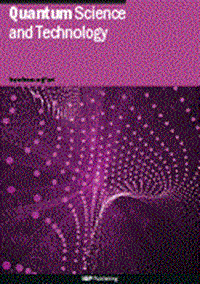利用x -催化剂增强量子退火中随机图问题的能隙
IF 5
2区 物理与天体物理
Q1 PHYSICS, MULTIDISCIPLINARY
引用次数: 0
摘要
解决量子退火组合优化问题的主要挑战之一是在退火哈密顿的基态和第一激发态之间出现极小的能量间隙。这些小间隙可能是潜在的一阶相变的症状,根据绝热定理,这可以大大延长所需的退火时间,使实际实施实际上不可行。在本文中,我们证明了在定义了最大加权独立集(MWIS)问题的图的所有边上附加一个xx -催化剂,可以显著增强最小能隙。值得注意的是,我们的分析表明,能隙越小,催化剂打开能隙的效果越好。该结果基于对Erdõs-Rényi和Barabáasi-Albert图上随机生成的大量MWIS问题实例执行的详细统计分析。我们使用随机和非随机催化剂进行分析。本文章由计算机程序翻译,如有差异,请以英文原文为准。
Enhancing the energy gap of random graph problems via XX-catalysts in quantum annealing
One of the main challenges in solving combinatorial optimisation problems with quantum annealers is the emergence of extremely small energy gaps between the ground state and the first excited state of the annealing Hamiltonian. These small gaps may be symptoms of an underlying first-order phase transition, which, according to the adiabatic theorem, can significantly extend the required anneal time, making practical implementation effectively infeasible. In this paper we demonstrate that attaching an XX-catalyst on all the edges of a graph upon which a MWIS (Maximum Weighted Independent Set) problem is defined, significantly enhances the minimum energy gap. Remarkably, our analysis shows that the smaller the energy gap, the more effective the catalyst is in opening it. This result is based on a detailed statistical analysis performed on a large number of randomly generated MWIS problem instances on both Erdõs–Rényi and Barabáasi–Albert graphs. We perform the analysis using both stoquastic and non-stoquastic catalysts.
求助全文
通过发布文献求助,成功后即可免费获取论文全文。
去求助
来源期刊

Quantum Science and Technology
Materials Science-Materials Science (miscellaneous)
CiteScore
11.20
自引率
3.00%
发文量
133
期刊介绍:
Driven by advances in technology and experimental capability, the last decade has seen the emergence of quantum technology: a new praxis for controlling the quantum world. It is now possible to engineer complex, multi-component systems that merge the once distinct fields of quantum optics and condensed matter physics.
Quantum Science and Technology is a new multidisciplinary, electronic-only journal, devoted to publishing research of the highest quality and impact covering theoretical and experimental advances in the fundamental science and application of all quantum-enabled technologies.
 求助内容:
求助内容: 应助结果提醒方式:
应助结果提醒方式:


